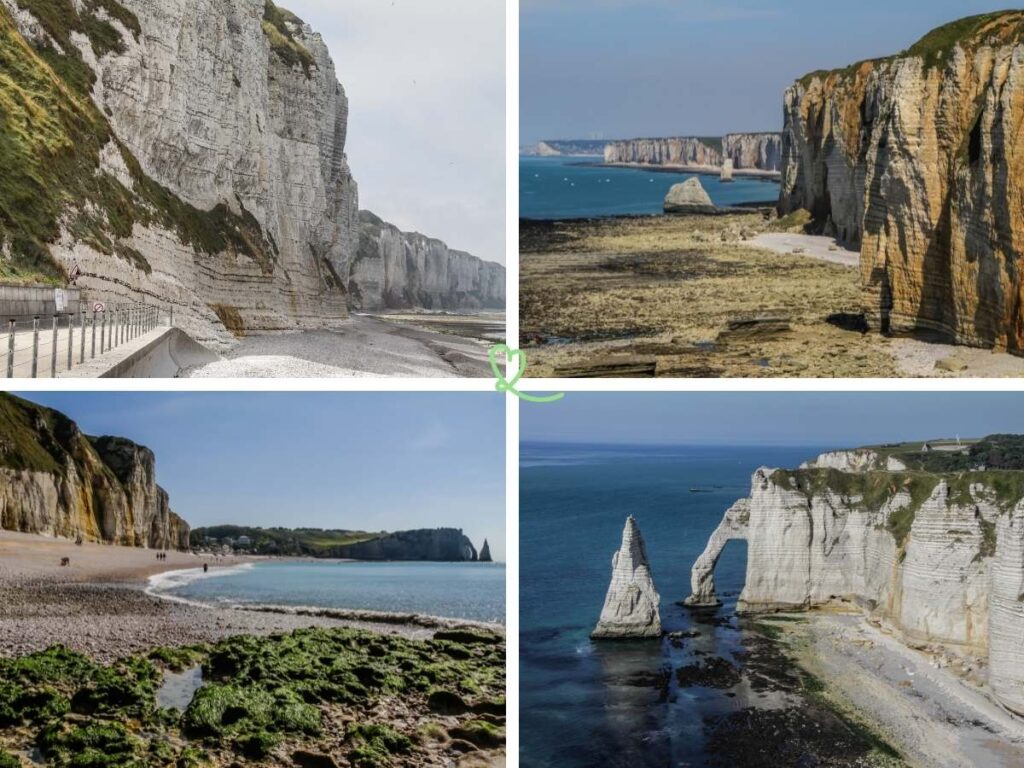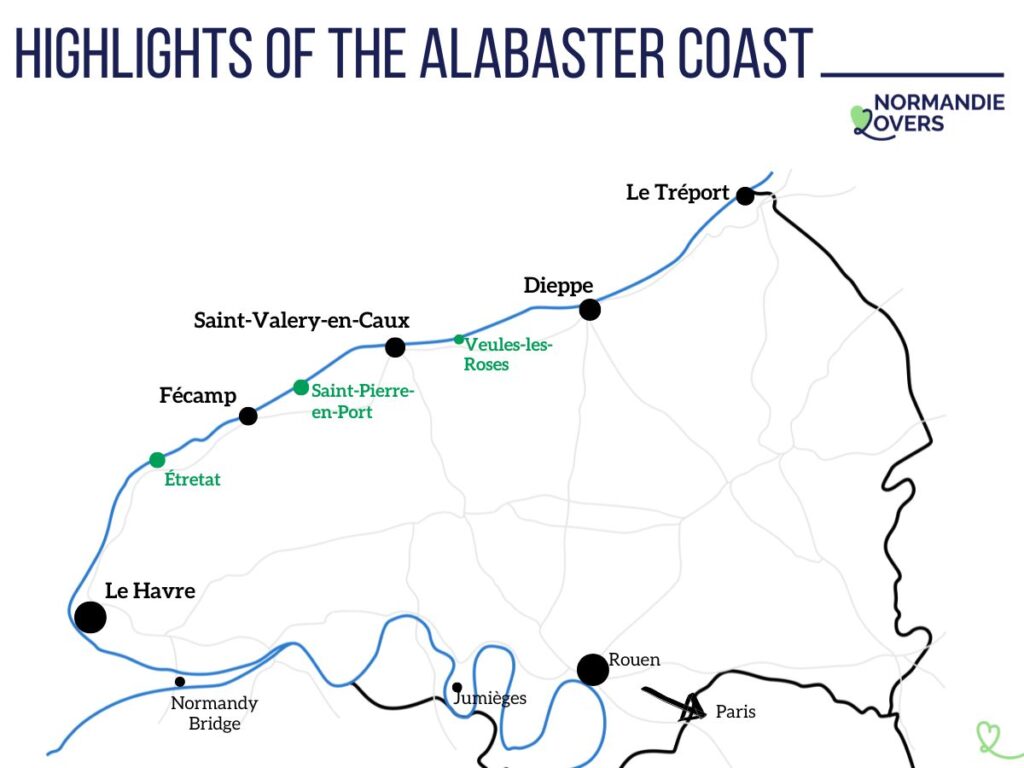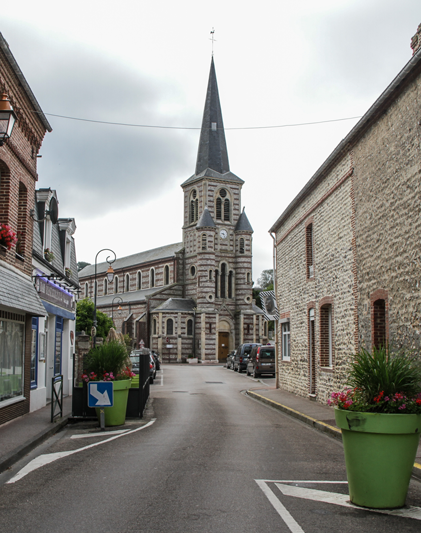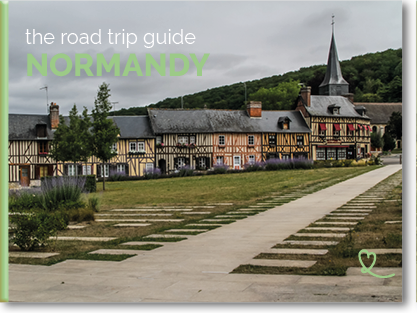The Alabaster Coast (Côte d’Albâtre ) is one of the jewels of Normandy. It offers some of the most magnificent cliffs in France and Europe.
All along the coast, you will be able to appreciate the white chalk cliffs sculpted by nature as well as the charming villages built by man.
Here is our guide: map, what to see and do on the Alabaster Coast, where to stay, where to spend a weekend, itinerary…

Why visit the Alabaster Coast in Normandy?
The Alabaster Coast is our favorite destination in Normandy. As we often say, a picture is worth a thousand words… So, let’s start with these 3 pictures taken in Étretat, the most famous section of the Alabaster Coast:

The cliffs are definitely the main attractions of this area. Sometimes, as in the photo below, you can see them continue to the horizon.
The coast is about 130 km long and there are cliffs from 30 to 105 m high almost everywhere. It is a must during a road trip in Normandy?

But, in fact, the Alabaster Coast is much more than just cliffs:
- Large and small towns with lots of character
- Tiny valleys carved into the cliffs
- Charming villages where it is good to walk
- Historic sites – Castles, churches and WWII bunkers.
I tell you more about them in this article, with many pictures!

Practical tips – Côte d’Albâtre, Normandy
How to get to the Alabaster Coast
- In the department of Seine-Maritime in Normandy
- Coast between Le Havre and Le Tréport
- Paris to Le Havre = 2h drive
- Rouen to Le Havre = 1 hour drive
- Paris to Le Tréport = 3h drive
- If you want to explore the coast, you need a private vehicle. Doing it by bus would not be easy.
- Below is a map that will help you identify some of the main places on the coast:

How long
- You can’t visit the coast on a day trip from Paris. You can visit one of the places (or two if they are close) on the coast, but that’s it.
- I think it takes a week to really explore the whole coast – but you can choose to visit only a few sites
- If you are limited in time, Étretat is a must-see. But for your other choices, I really can’t decide. Take a look below and choose according to our preferences.
OUR ADVICE FOR RENTING A CAR IN Normandy
- Compare prices on our preferred platform: DiscoverCars – one of the best rated sites.
- Choose a car that is comfortable enough (distances can be long) but compact (some parking lots and villages are narrow).
- Think of thecomplete insurance (some roads are tortuous and narrow).
- There is a lot of demand, book it early.

Tips for your visit – weekend in Côte d’Albâtre or more
- The coast is a windy place, but the sun can also be harsh – be sure to pack several layers of clothing to accommodate the weather during the day.
- Be careful, the cliffs are made of chalk, so they are not very stable. You should not walk on the edge and you should not lie down at the foot of the cliffs.
- The pebbles and rocks of the beach are very difficult to approach. It is not ideal for walking. Bring good shoes if you leave the concrete walkway.

Where to stay on the Alabaster Coast – itinerary
General advice
You can make a circuit by sleeping in several places to enjoy each corner (see next section).
But if you prefer to stay in one place all week to explore the area, the small town of Saint-Valery-en-Caux is central enough for the whole coast. It is therefore an ideal base for exploring the region.
Discover the best rated accommodations in Saint-Valéry
In this article you can find options in the main cities and small villages. See your options in the sections below.
We think a night in Étretat is worth it, to see the sunset with these magnificent cliffs and to enjoy the view at low and high tide.
For example, the Domaine Saint-Clair, Hôtel Le Donjon is a truly elegant cocoon with spa and pool – see prices, photos and availability
Otherwise, see all the best rated accommodations in Étretat // or see our selection of the best hotels.

Itinerary of the Alabaster Coast tour
If you have one week, here is my suggestion for your tour in Côte d’Albâtre :
1 night in Le Havre – see the best rated accommodations
2 nights in Étretat – see the best rated accommodations
1 night in Fécamp – see the best rated accommodations
1 night in Saint-Valéry-en-Caux – see the best rated accommodations
1 night in Dieppe – see the best rated accommodations
1 night in Le Tréport – see the best rated accommodations
USE OUR GUIDE TO PLAN A
DREAM TRIP TO Normandy
All the information you need for your trip:
- 8 maps that make planning easier
- 160+ pre-selected locations
- Practical advice
- 300+ photos to help you choose

4 most beautiful views of the cliffs – what to see on the Alabaster Coast
If you visit the coast, the cliffs are the main attractions. Most of the time, you can see them from the water level on the beach. But there are some viewpoints from the top of the cliffs where you can admire them better. Here are our favorite places.
#1. Cap Fagnet

Near the town of Fécamp, you can go to Cap Fagnet by car or on foot. The place is famous for its church, its World War II bunkers and for the impressive views it offers.
On one side, you can see the whole town of Fécamp and the cliffs to the south.
But my favorite thing is to walk a bit north on the path to admire the wall of cliffs to the north with waves carved by the sea.
There is a large parking lot, it is easy to access.
Read more
#2. Étretat – Downstream cliffs


When you are limited in time, it can be difficult to choose between climbing the northern or southern cliffs of Étretat. Both offer magnificent views. However, my first choice is the South Cliff. But don’t stop at the first viewpoint near the hollow needle. Go further to the Manneporte Arch for beautiful views of the famous pinnacles and the main arch.
This side can only be reached on foot through a steep slope.
To plan your stay, see our article on Étretat.
#3. Étretat – View from the upper cliffs

But if you are fit enough, I recommend you also climb the other side (steep stairs from the promenade, or by road (less steep but longer) or during the tourist season they have public transport.
On this side, you have the gardens with works of art, the aviation monument, the chapel and the most famous view of Étretat towards the thin arch and the pinnacle. You can even see the hole that allows you to reach the next beach at low tide.
#4. Le Tréport from the other side of the port

My final viewpoint selection is quite different. While visiting Le Tréport, head to the next town of Mers-les-Bains (which is not in Normandy). Once across the mouth of the harbor, you have a view of the historic district of Le Tréport and the massive cliffs behind. These are among the highest on the coast!
4 valleys and stairs
As you can see above, there are miles and miles of high cliffs.
But from time to time, there are accesses to the sea through stairs built by man or through valleys created by nature, called Valleuses. Or a mixture of both.
The valleys are rather cuts. They are quite unique in terms of geology. They were created 2 million years ago, when the ground was raised and by erosion.
Below are some of our favorite places to explore.
#5. Varengeville – Gorge des Moutiers

My first choice is a natural valley cut. The narrow gorge of Moutiers is very impressive when you arrive on the beach between the cliffs.
The walk starts next to a charming chapel on top of the cliffs.
The last section is quite steep (and people with vertigo will have a hard time getting through it) but I think it’s worth it.

#6. Stairs of Sotteville

In Sotteville, you will find a man-made access to the sea. It was dug in the chalk in 1890. At the time, it was intended to give fishermen access to the sea. The original steps were made of wood, but they were dynamited during the occupation.
The current staircase was built in 1954 with 231 steps.
I like them because they give access to the impressive cliff wall.
At low tide, you can walk on the beach, but at high tide, you feel like you’re walking directly into the sea.

#7. Saint-Pierre-en-Port

The Valleuse de Saint-Pierre-en-Port was cut off by the waters. The opening is quite large and the experience different from other places in the section. However, the area is still without too many houses and the views from the cliff are impressive.
I recommend a visit at low tide to see all the locals collecting seafood.

#8. Berneval

Berneval is most famous for having been one of the landing sites for an Anglo-Canadian raid during the Second World War in 1942: Operation Jubilee. Unfortunately, the ships encountered a German convoy and the landing did not go as planned. Many lives were lost. You will find more explanations on the site.
But to reach the beach, you can enjoy a beautiful double staircase and the views of the cliffs from the last stair platform are spectacular!

3 villages – places of tourism of the Alabaster Coast
Other attractions of the Alabaster Coast are the villages nestled in the valleys or on top of the cliffs. Some of them have a lot of charm and are worth visiting.
#9. Veules-les-Roses

Veules-les-Roses is one of the most famous villages in Normandy. It has the label “Les plus beaux villages de France”.
It is a charming village with a particularity. It is built around the shortest river in France, the Veules, which is 1194 km long.
This means that you can easily walk the whole length from the spring to the sea. See more pictures in our article about Veules-Les-Roses.
The village has set up a walking trail with informative signs that take you along the river and into the village. You will discover :
- the watercourses
- the mills
- the old half-timbered houses
- flint houses
- …
Large parking lots have been built at the entrance of the village.
Allow at least 3 hours to enjoy the entire loop with a climb to the viewpoints.
You want to stay in Veules-les-Roses? See the best rated accommodations in the area.

#10. Village of Yport

Yport is much less known and is one of my favorite villages on the coast (but it is still very touristy with French visitors).
It was once a fishing village. But it became popular in the 19th century, when sea bathing was the thing to do.
I love the beach with the blue and white huts and the arch inside the cliffs.
And I also recommend a walk in the village to appreciate the typical flint houses of the region. They are in very good condition.
The church is also a main attraction with miniature boats inside and a beautiful two-tone design on the outside.
You want to stay in Yport ? See the best rated accommodations in the area.

#11. Étretat

Étretat is famous for its cliffs, but the village is also worth a visit.
You will find an old church, rows of two-tone brick houses and a market hall with a lot of character.
The hall is called “Covered Market”. Today, you can find souvenir stores there. It is a wooden structure dating from 1926. Before, a farm was located here.
You want to stay in Étretat ? See the best rated accommodations in the area.

And of course, you are never far from the beach… always a spectacular view!
See more photos in our article on Étretat.

9 beaches to walk on – what to do on the Alabaster Coast
Beaches for lying down are not really my thing.
We have listed, above in the article, some of the most spectacular beaches to admire the cliffs like Étretat and the Valleuses and stairs to reach the isolated areas. These are some of the most beautiful beaches in Normandy.
But some of you might want to take a break one day, and spend a day relaxing on the beach. Here is some information and suggestions.

Pebble beaches
First of all, you should know that all the beaches of the Alabaster Coast are made of pebbles.
At low tide, there may be sand, depending on the slope of the beach, but you will mostly lie on pebbles (of various sizes).

#12 to 20 – beaches of the Alabaster Coast
Some of the larger beaches have facilities for relaxation:
- Le Havre (see next section)
- Saint-Jouin-de-Bruneval (with a beautiful view of the cliff) – one of the best options in my opinion
- Fécamp (see next section)
- Veulettes sur mer
- Saint-Valery-en-Caux (see next section)
- Quiberville
- Hautot-sur-Mer
- Dieppe (see next section)
- Criel Beach



The 5 cities of this Normandy coast of Seine-Maritime
Let’s see now the main cities of the coast.
They all have a very different atmosphere and many points of interest to explore.
Below you will find an introduction to each of them, some of the most beautiful cities in Normandy.
#21. Le Havre

Why visit Le Havre
First of all, this is my hometown. Isn’t that reason enough for you?
Well, it is also a Unesco World Heritage Site because of its particular post-war architecture.
What I like most is the mix of modern art with the square lines of the architecture and the incredible skies we have sometimes with great light.
Main points of interest
- Perret’s architecture, including the city hall and the church of St. Joseph
- Modern art throughout the city, especially the Catena with its colorful containers (by Vincent Ganivet)
- The “volcano”, the architectural theater of Oscar Niemeyer
- The waterfront and its particular light which inspired many painters.
Learn more in our article on Le Havre

Tips for visiting
- Le Havre is very easy to explore on foot
- Plan on at least half a day – but a day is better
- Try to visit the church in the sunlight – the play of light through the hundreds of stained glass windows is magnificent
- See the best rated accommodations in Le Havre

#22. Fécamp

Why visit Fécamp
Fécamp is especially famous for its Benedictine palace where the liqueur is made. Even if you don’t visit the interior and the factory, stop by the building to appreciate its architecture.
But Fécamp is also an intriguing combination of interest with religious pilgrimage sites and fishing port traditions. It is a city turned towards the sea.
Main points of interest
- The Benedictine Palace and its alcohol factory
- Museums about fishermen
- Cap Fagnet with its bunkers and its magnificent views of the coast
Learn more in our article about the city of Fécamp.

Tips for visiting
- First, plan your visit to the palace. Reserve in advance. Then organize the rest around this visit.
- Large parking lots by the sea. But on nice summer weekends, it can be difficult to find a place to park.
- Plan on at least half a day, but a day is better
- See the best rated accommodations in Fécamp

#23. Saint-Valery-en-Caux

Why visit Saint-Valéry
I was pleasantly surprised by Saint-Valery. It is often overlooked in comparison to other cities. But I really enjoyed the atmosphere here. It is very pleasant to walk on the port. This city is also very much linked to the sea. And when you walk on the dikes, the view of the cliffs and beaches is very beautiful.
Main points of interest
- Maison Henri IV – Half-timbered house and museum
- Walk in the port
- Chapel with blue stained glass windows

Tips for visiting
- Easy to explore on foot
- Be sure to see the beach at low and high tide for a change of scenery
- Allow half a day or take advantage of its central location to explore the entire coast.
- Large parking lots on both sides of the harbor (however, it can also be difficult to park during the beautiful summer weekends)
- Discover the best rated accommodations in Saint-Valéry-en-Caux

#24. Dieppe

Why visit Dieppe
Dieppe is home to one of the few fortified castles in the Normandy region. That’s what sets it apart.
The structure of the city, with the port creating a kind of peninsula, is quite interesting.
I really enjoyed walking around the city and discovering its many facets.
Main points of interest
- Old fortified castle
- Remaining door Les Tourelles
- The churches
- The impressive protected port

Tips for visiting
- Easy to navigate
- The castle is located at the top of the cliff – you can reach it by foot or by car (but parking spaces are limited)
- Plan at least half a day
- Discover the best rated accommodations in Dieppe

#25. Le Tréport

Why visit Le Tréport
It is another city whose life is strongly focused on the sea. It is a commercial port, a marina and a fishing port.
Its location at the foot of the highest cliffs in Europe makes it quite impressive.
Main points of interest
- The view from the top of the funicular
- The height of the cliffs (the highest in Europe with over 100m, about 348ft)
- The old district called Cordier

Tips for visiting
- Park at the top of the cliff and take the funicular down into town – you’ll spend less time looking for a space and driving very slowly.
- Plan a half day
- Discover the best rated accommodations in Le Tréport

3 places of the Second World War
Finally, the coast is also full of relics from the Second World War.
Most people go to Omaha Beach and Utah Beach, on the sandy side of the Normandy coast further south.
But the Alabaster Coast also has some interesting sites. You can find blockhouses here and there, all along the coast. Here are some of the most interesting ones.
#26. Quiberville-sur-Mer

At the northern end of the beach of Quiberville-sur-Mer, a blockhouse can be seen fallen from the cliffs.
It is still a favorite of photographers.
#27. Cap Fagnet

As I wrote earlier, near Fécamp, there is the Cap Fagnet with its chapel and its magnificent views. It is also the location of several bunkers including the large Matmut.
It is one of the best preserved sites in this part of Normandy. You will find explanatory signs nearby.
#28. Berneval

And as I have already written, in Berneval you can also discover the tragic story of Operation Jubilee.
There is not much to see, but it is an interesting place to see what the soldiers had to face during the landing.
A paradise for hikers – GR21 and short hikes
If you like hiking, the Côte d’Albâtre region is also full of hiking trails, including the famous GR21. It was elected in 2020 as the favorite hiking route of the French.
You can walk the entire trail (190km), or enjoy small portions of it, like in Étretat.



